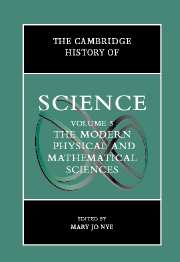Book contents
- Frontmatter
- Introduction: The Modern Physical and Mathematical Sciences
- Part I The Public Cultures of the Physical Sciences After 1800
- Part II Discipline Building in the Sciences: Places, Instruments, Communication
- Part III Chemistry and Physics: Problems Through the Early 1900s
- Part IV Atomic and Molecular Sciences in the Twentieth Century
- Part V Mathematics, Astronomy, and Cosmology Since the Eighteenth Century
- 23 The Geometrical Tradition: Mathematics, Space, and Reason in the Nineteenth Century
- 24 Between Rigor and Applications: Developments in the Concept of Function in Mathematical Analysis
- 25 Statistics and Physical Theories
- 26 Solar Science and Astrophysics
- 27 Cosmologies and Cosmogonies of Space and Time
- 28 The Physics and Chemistry of the Earth
- Part VI Problems and Promises at the End of the Twentieth Century
- Index
- References
25 - Statistics and Physical Theories
from Part V - Mathematics, Astronomy, and Cosmology Since the Eighteenth Century
Published online by Cambridge University Press: 28 March 2008
- Frontmatter
- Introduction: The Modern Physical and Mathematical Sciences
- Part I The Public Cultures of the Physical Sciences After 1800
- Part II Discipline Building in the Sciences: Places, Instruments, Communication
- Part III Chemistry and Physics: Problems Through the Early 1900s
- Part IV Atomic and Molecular Sciences in the Twentieth Century
- Part V Mathematics, Astronomy, and Cosmology Since the Eighteenth Century
- 23 The Geometrical Tradition: Mathematics, Space, and Reason in the Nineteenth Century
- 24 Between Rigor and Applications: Developments in the Concept of Function in Mathematical Analysis
- 25 Statistics and Physical Theories
- 26 Solar Science and Astrophysics
- 27 Cosmologies and Cosmogonies of Space and Time
- 28 The Physics and Chemistry of the Earth
- Part VI Problems and Promises at the End of the Twentieth Century
- Index
- References
Summary
Until about 1840, the theory of probability was used almost exclusively to describe and to manage the imperfections of human observation and reasoning. The introduction of statistical methods to physics, which began in the late 1850s, was part of the process through which the mathematics of chance and variation was deployed to represent objects and processes in the world. If this was a “probabilistic revolution,” it was a multifarious and gradual one, the vast scope of which went largely unremarked. Yet it challenged some basic scientific assumptions about explanation, metaphysics, and even morality. For this reason, it sometimes provoked searching reflection and debate within particular fields, including physics, over what, in retrospect, appears as an important new direction in science.
At the most basic level, statistical method meant replacing fundamental laws whose action was universal and deterministic with broad characterizations of heterogeneous collectives. Statistics, whether of human societies or of molecular systems, involved a shift from the individual to the population and from direct causality to mass regularity. In social writings, it was linked to bold claims for scientific naturalism. Statisticians claimed to have uncovered a lawlike social order governing human acts and decisions that had so far been comprehended by Christian moral philosophy in terms of divine intentionality and human will. Their science seemed to devalue moral agency, perhaps even to deny human freedom. In other contexts, and especially in physics, statistical principles appeared, rather, to limit the domain of scientific certainty. They directed attention to merely probabilistic regularities, the truth of which was uncertain and approximate.
- Type
- Chapter
- Information
- The Cambridge History of Science , pp. 488 - 504Publisher: Cambridge University PressPrint publication year: 2002
References
- 4
- Cited by



